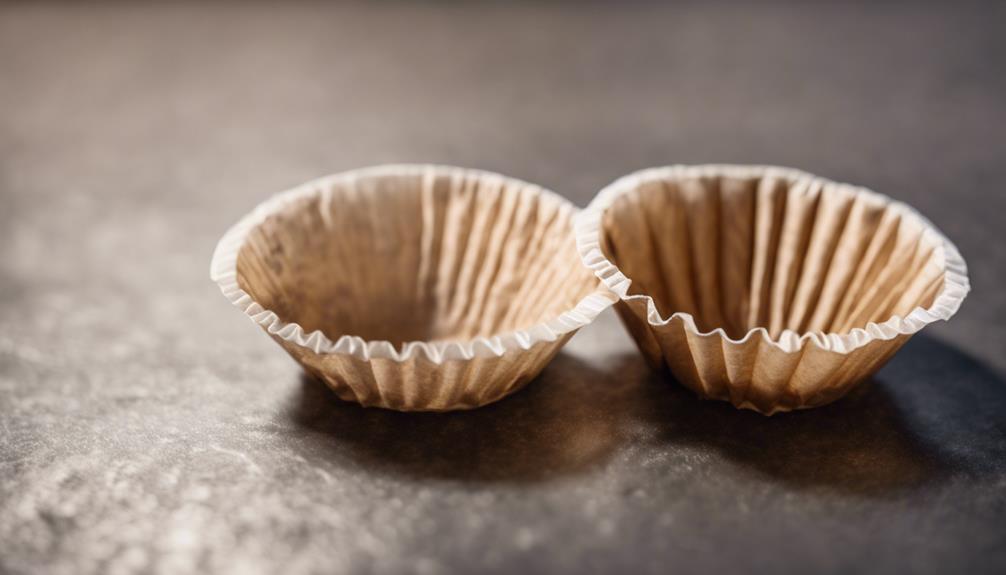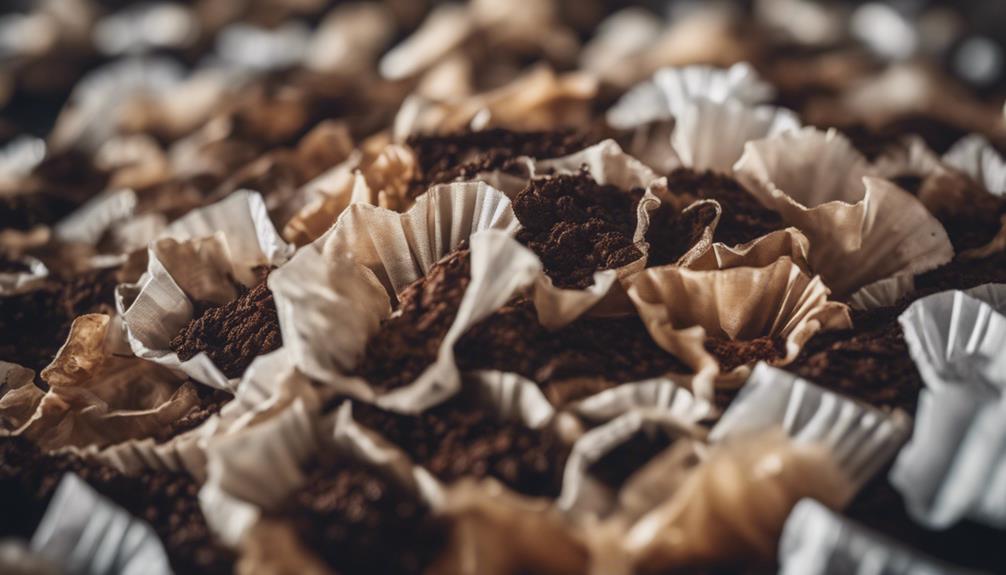Coffee filters do not have a specific expiration date, but their quality can deteriorate over time due to storage conditions and environmental factors. It is important to store them in a cool, dry place to maintain their effectiveness. Exposure to moisture and strong odors can affect the quality of the filters, which can impact the taste of your coffee. Look out for changes in texture and color fading as signs that the filters may need to be replaced. Replacing filters every 1-2 weeks will ensure they are performing at their best. Understand how storage can affect your filters to enhance your coffee experience. For more information on signs of degradation and best storage practices, visit this link.
Key Takeaways
- Coffee filters do not have a strict expiration date.
- Filters can degrade over time, affecting performance.
- Signs of degradation include changes in texture and color.
- Regularly replacing filters every 1-2 weeks maintains quality.
- Proper storage in a cool, dry place prolongs filter lifespan.
Factors Affecting Coffee Filter Longevity
Proper storage plays an essential role in maintaining the longevity of coffee filters. While it may seem like a humble accessory, the way you store your paper filters can greatly impact their lifespan.
Coffee enthusiasts often wonder if coffee filters go bad, and the answer lies in how you care for them. Exposure to moisture can degrade the quality of the filters over time, affecting their performance when brewing your beloved cup of coffee. Filters stored near strong odors, such as spices, may absorb unwanted flavors, ultimately impacting the taste of your coffee.
To guarantee your filters last as long as possible, it's important to practice proper storage techniques. Regularly checking for signs of moisture absorption or odor transfer is crucial in maintaining the quality of your filters. Additionally, inspecting filters for changes in texture or appearance can serve as indicators of their effectiveness over time.
How Storage Conditions Impact Filters

Storing your paper coffee filters in a cool, dry place is essential for maintaining their quality and lifespan. Exposure to moisture can compromise the effectiveness of the filters over time, impacting the flavor of your brewed coffee.
Proper care, including avoiding storing filters near strong odors, is necessary to guarantee your filters remain in top condition for the best coffee experience.
Storage and Filter Lifespan
To maintain the quality and effectiveness of your paper coffee filters, it's crucial to store them in a cool, dry place. Exposure to moisture can deteriorate the filters, impacting the taste of the brewed coffee.
Check for any signs of moisture absorption and store them away from strong odors like spices, as these can affect the flavor of your filter coffee.
Proper storage not only preserves the integrity of the filters but also guarantees that they don't lose effectiveness over time. Regularly inspect the filters for any changes in texture or appearance to confirm they're suitable for use.
Environmental Factors Affecting Filters
When considering the environmental factors that affect coffee filters, it's important to understand how storage conditions can directly impact their quality and performance.
Paper filters are sensitive to their surroundings; being stored near strong odors like spices can lead to the absorption of these scents, ultimately affecting the taste of the coffee brewed with them.
Additionally, moisture in the environment poses another challenge, as it can compromise the quality of paper filters, potentially resulting in mold growth in humid conditions.
To maintain the integrity of paper filters and prevent any odor transfer, it's vital to store them properly in a cool, dry place.
Factors such as exposure to moisture or strong odors can contribute to changes in filter quality over time. Hence, inspecting stored paper filters for any signs of damage, odor absorption, or expiration date is recommended to ensure their effectiveness when brewing coffee.
Proper storage practices play a significant role in preserving the quality of your filters and ultimately enhancing your coffee experience.
Proper Care for Filters
Proper care for your coffee filters involves storing them in a cool, dry place to maintain their quality and integrity. Exposure to moisture can greatly impact the effectiveness of paper filters, leading to potential brewing issues. Additionally, storing filters near strong odors, such as spices, can transfer unwanted flavors and compromise the taste of your coffee.
By guaranteeing proper storage conditions, you can prevent problems like moisture absorption and odor transfer, ultimately preserving the quality of your filters. It's essential to regularly check your stored paper filters for any signs of damage or changes in texture. This simple practice will help you identify any issues early on and ensure that your filters continue to perform at their best.
Signs of Degraded Coffee Filters

In addition, expired coffee filters can exhibit changes in texture, such as becoming brittle or flimsy, indicating degradation.
Color fading may also occur, signaling a loss of quality in the filter.
Moreover, degraded filters mightn't effectively filter coffee grounds, leading to a decrease in filtration efficiency.
Filter Texture Changes
Monitoring the texture of your coffee filters is essential to guarantee high-quality brewing quality and performance. Changes in texture, such as brittleness, softness, or discoloration, can be signs of degraded coffee filters.
When filters degrade, they may not effectively filter out coffee grounds, leading to a weaker brew or unwanted particles in your coffee. The breakdown of the filter material, indicated by texture changes, can impact its ability to trap coffee oils and particles, affecting the overall taste and quality of your brewed coffee.
Regularly inspecting the texture of your filters is important to maintain the desired flavor profile in your coffee and to sustain optimal brewing performance.
Color Fading
Observing a fading color in your coffee filters can serve as a visual cue indicating potential degradation over time. Color changes in your filters may suggest a decrease in quality, leading to a reduced performance during brewing. It is essential to keep an eye out for any noticeable alterations in the color of your coffee filters as these variations can be a clear indicator that the filters are past their peak use period. To help you understand better, here is a table highlighting signs of color fading in coffee filters:
| Sign of Color Fading | Implication | Action Required |
|---|---|---|
| Faded or Lightened Color | Potential filter degradation | Consider replacing the filters |
| Yellowing or Browing | Loss of filter effectiveness | Test filtration efficiency |
| Inconsistent Color | Filter material breakdown | Monitor for further changes |
Reduced Filtration Efficiency
To guarantee excellent coffee quality, pay attention to signs of decreased filtration efficiency in your coffee filters. Reduced filtration efficiency is a common indication that your filters may be past their prime.
When filters start to degrade, they may not effectively trap all the coffee grounds, leading to sediment in your brewed coffee. This can affect the overall taste and quality of your coffee, resulting in a weaker or inconsistent flavor profile.
Additionally, old and degraded filters are more prone to tearing or collapsing during use, which can disrupt the brewing process and impact the final coffee output. It's highly recommended to replace your coffee filters regularly to ensure top-notch filtration performance and maintain the high quality of your coffee.
Impact of Expired Filters on Taste

Expired coffee filters can significantly impact the taste of your brewed coffee due to their reduced filtration efficiency. When filters pass their expiration date, their ability to trap coffee grounds diminishes, leading to a direct influence on the flavor of your coffee. This can result in a brew that's either weaker or stronger than desired, affecting the overall taste experience.
Additionally, using expired filters may introduce sediment or grounds into your coffee, further altering its quality and smoothness.
It is important to understand that the expiration date on coffee filters signifies a decline in their effectiveness rather than a risk of spoilage. To maintain the desired flavor profile of your coffee, it's recommended to replace expired filters promptly. By doing so, you can make sure that your brewed coffee retains its intended taste without unwanted variations caused by the use of filters past their prime. Additionally, using expired coffee filters can also impact the overall experience of drinking your coffee. The buildup of oils and sediment from prolonged use can result in a muddier and less vibrant brew. In fact, many coffee enthusiasts have found that using coffee filters as parchment paper in a pinch can result in a subpar brewing process and a less satisfying cup of coffee. Therefore, it is best to replace your coffee filters regularly to ensure the best possible coffee-drinking experience.
Recommended Replacement Frequency

Regularly replacing your coffee filters is essential to maintaining peak performance and enhancing the taste of your brewed coffee. Here's why it's important:
- Optimal Performance: Swapping out paper filters every 1-2 weeks guarantees they function effectively, preventing any buildup or clogs that could impact the brewing process.
- Quality Maintenance: Regular filter changes help uphold the quality of your coffee by ensuring that only clean and efficient filters are used during brewing.
- Enhanced Taste: Fresh filters contribute to a better tasting cup of coffee, as old or overused filters may alter the flavor due to accumulated residues or reduced filtration capacity.
Best Practices for Filter Storage

Store your paper filters in a cool, dry location to maintain their quality and guarantee the best brewing results. Exposure to moisture can greatly impact the effectiveness of paper filters, potentially altering the taste of your coffee.
It's important to keep filters away from strong odors such as spices, as these can transfer onto the filters and affect the flavor of the brewed coffee. By storing your filters properly, you can preserve their integrity and ensure excellent brewing every time.
Check for any signs of moisture absorption or odor transfer regularly to maintain the quality of your filters. Remember, the way you store your filters plays an important role in the quality of your coffee, so taking care in this aspect can make a noticeable difference in your brewing experience.
Can Filters Be Revived?

To potentially revive old paper filters, consider evaluating their condition before attempting any restoration methods. Reviving filters can be challenging due to factors like odors or moisture absorption over time. Here are three important points to keep in mind:
- Assessing Condition:
Before trying to revive a filter, check for signs of damage or strong odors. If the filter appears discolored, torn, or has a noticeable smell, it may be best to discard it and use a new one for best results.
- Odor Absorption:
Paper filters are porous and can easily absorb odors from their surroundings. If a filter has taken on strong smells, rinsing or airing it out may not fully remove the odor, affecting the taste of your coffee.
- Moisture Damage:
Exposure to humid environments can impact the quality of paper filters. Once moisture has compromised the integrity of a filter, attempting to revive it may not yield satisfactory results. It's advisable to replace filters regularly for a fresh and flavorful brew.
Environmental Impact of Disposable Filters

Environmental factors greatly impact the integrity and performance of disposable paper filters used in brewing coffee. Paper filters have a tendency to absorb odors from their surroundings, potentially tainting the flavor of your coffee.
Storing filters near strong-smelling items like spices can lead to flavor contamination, affecting the quality of your brew. Additionally, moisture in the environment can also play a significant role in the preservation of paper filter integrity.
It's essential to store disposable filters properly, away from odors and moisture, to maintain the desired flavor profile of your coffee. By being mindful of your storage practices, you can ensure that your paper filters perform at their best and contribute positively to your overall coffee experience.
Understanding and addressing the environmental impact on disposable filters is vital for consistently enjoying a delicious cup of coffee.
Reusable Filter Options

When contemplating filter options for your coffee brewing setup, reusable filters, such as metal or mesh varieties, offer a durable and long-lasting alternative to disposable paper filters. These filters provide a sustainable and cost-effective solution for your daily caffeine fix.
Here are some key points to keep in mind:
- Durability: Unlike paper filters that need to be replaced after each use, reusable metal or mesh filters are designed to last for a long time. They don't degrade over time and can withstand multiple uses with proper care.
- Maintenance: Regular cleaning and upkeep are essential to ensure the best performance of reusable filters. By keeping them clean and free of residue buildup, you can prolong their lifespan and maintain the quality of your coffee.
- Cost-Effectiveness: While reusable filters may have a higher upfront cost than disposable paper filters, investing in a high-quality reusable filter can save you money in the long run. You won't need to constantly purchase new filters, making it a more sustainable and economical choice for avid coffee drinkers.
Frequently Asked Questions
Does a Coffee Filter Go Bad?
Coffee filters do not go bad in the traditional sense. However, they can lose efficiency over time, affecting the quality of your brew.
Expiration dates on filters indicate a decrease in effectiveness, not spoilage. Proper storage can prevent deterioration.
Check expiry dates before use to guarantee peak performance. Regular maintenance and inspection can help extend the lifespan of your coffee filters.
Keep them fresh for a superior coffee experience.
What Is the Shelf Life of Filter Coffee?
The shelf life of filter coffee varies based on factors like the roast level, packaging, and storage conditions. For best freshness, aim to consume your coffee within 2-4 weeks after roasting.
Properly sealed bags or airtight containers can extend the coffee's quality. Remember that exposure to air, light, and moisture accelerates flavor degradation.
To enjoy the best-tasting coffee, prioritize freshness by adhering to these storage guidelines.
How Long Do Cloth Coffee Filters Last?
Cloth coffee filters typically last for up to a year when properly cared for. Regular cleaning and rinsing can prolong their lifespan.
While they may develop stains and discoloration over time, this doesn't usually affect their performance. Avoid using harsh chemicals or detergents when cleaning cloth filters to maintain their quality.
Periodically inspect filters for wear, tears, or thinning fabric that may impact filtration efficiency.
What Can Old Coffee Filters Be Used For?
Old coffee filters, despite being used, serve multiple practical purposes. Have you considered using them for streak-free glass cleaning or as disposable snack plates?
Strain impurities from broths or protect surfaces from water rings with these versatile filters. They can also safeguard delicate items during storage or packing.
Embrace the potential of old coffee filters beyond their primary use for a sustainable and resourceful approach in daily tasks.
Conclusion
In the world of coffee filters, time can be a cruel companion, leading to their demise. Just like a fading sunset, expired filters lose their effectiveness, impacting the flavor of your beloved brew.
By understanding the signs of degradation and following recommended replacement frequencies, you can guarantee a fresh and delicious cup every time.
Remember, a well-preserved filter is like a loyal friend, providing you with the perfect brewing experience.









